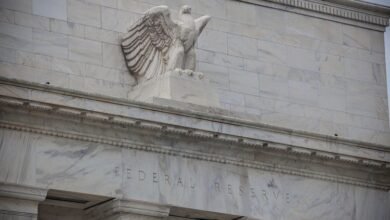Gold price struggles to gain any meaningful traction, flat lines above $2,400 mark

- Gold price consolidates in a range and is influenced by a combination of diverging forces.
- The risk-on impulse, rebounding US bond yields and a modest USD uptick cap the upside.
- Bets for a 50-bps Fed rate cut in September and persistent geopolitical tensions lend support.
Gold price (XAU/USD) struggles to capitalize on the previous day’s goodish rebound from the 50-day Simple Moving Average (SMA) support around the $2,365-2,364 region, or a one-week low and oscillates in a range during the Asian session on Tuesday. A turnaround in the global risk sentiment – as depicted by a relief rally in the equity markets – is seen acting as a headwind for the safe-haven precious metal. Furthermore, rebounding US Treasury bond yields lend some support to the US Dollar (USD) and contribute to capping the upside for the non-yielding yellow metal.
The incoming softer US macro data fueled worries about a downturn in the world’s largest economy and raised expectations for bigger interest rate cuts by the Federal Reserve (Fed). This should keep a lid on any meaningful upside for the US bond yields and the USD, which, along with geopolitical risks stemming from the ongoing conflicts in the Middle East, should continue to offer some support to the Gold price. This warrants caution before positioning for an extension of last week’s downfall from the vicinity of the all-time peak amid absent relevant US economic releases.
Daily Digest Market Movers: Gold price is undermined by positive risk tone, Fed rate cut bets to limit downside
- The US macro data released last week showed that business activity in the manufacturing sector contracted more sharply than expected in July and jobs growth slowed more than anticipated last month.
- This sparks fear of a possible recession in the US and the prospects for a more aggressive policy easing by the Federal Reserve, which, in turn, triggered the recent steep decline in the US Treasury bond yields.
- In fact, the yield on the benchmark 10-year US government bond slumped to its lowest level since mid-2023 as traders are now pricing in a near 100% chance of a 50-basis points Fed rate cut in September.
- This, to a larger extent, overshadowed Tuesday’s upbeat release of the US Services PMI, which improved to 51.4 in July from 48.8 in the previous month and surpassed consensus estimates for a reading of 51.
- San Francisco Fed President Mary Daly said on Monday that a slowing job market isn’t yet reason for alarm and reiterated that interest rates will come down to preserve the balance of full employment and price stability.
- Meanwhile, Iran, Hamas and the Lebanese group Hezbollah pledged to retaliate against Israel for last week’s assassination of Hamas political chief Ismail Haniyeh in Tehran, further underpinning the safe-haven metal.
- That said, the risk-on impulse, along with rebounding US Treasury bond yields and a modest US Dollar uptick, fails to assist the commodity in attracting meaningful buyers during the Asian session on Tuesday.
Technical Analysis: Gold price bulls have the upper hand while above 50-day SMA support near $2,365-2,364 area
From a technical perspective, the overnight bounce reaffirmed strong support near the 50-day SMA, currently pegged near the $2,365-2,364 area. This should now act as a key pivotal point for short-term traders, which if broken decisively should pave the way for an extension of the recent pullback from the vicinity of the all-time peak. Some follow-through selling below last week’s swing low, around the $2,353-2,352 region, will reaffirm the negative bias and drag the Gold price to the $2,342 zone, or the 100-day SMA. A convincing break below the latter might shift the near-term bias in favor of bearish traders and prompt aggressive technical selling.
On the flip side, the $2,430 level could offer some immediate resistance ahead of the $2,448-2,450 horizontal zone. The next relevant hurdle is pegged near the $2,468-2,469 region, above which the Gold price could aim to challenge the all-time top near the $2,483-2,484 area touched in July. The latter is followed by the $2,500 psychological mark, which if cleared decisively will set the stage for a further near-term appreciating move.
Interest rates FAQs
Interest rates are charged by financial institutions on loans to borrowers and are paid as interest to savers and depositors. They are influenced by base lending rates, which are set by central banks in response to changes in the economy. Central banks normally have a mandate to ensure price stability, which in most cases means targeting a core inflation rate of around 2%. If inflation falls below target the central bank may cut base lending rates, with a view to stimulating lending and boosting the economy. If inflation rises substantially above 2% it normally results in the central bank raising base lending rates in an attempt to lower inflation.
Higher interest rates generally help strengthen a country’s currency as they make it a more attractive place for global investors to park their money.
Higher interest rates overall weigh on the price of Gold because they increase the opportunity cost of holding Gold instead of investing in an interest-bearing asset or placing cash in the bank. If interest rates are high that usually pushes up the price of the US Dollar (USD), and since Gold is priced in Dollars, this has the effect of lowering the price of Gold.
The Fed funds rate is the overnight rate at which US banks lend to each other. It is the oft-quoted headline rate set by the Federal Reserve at its FOMC meetings. It is set as a range, for example 4.75%-5.00%, though the upper limit (in that case 5.00%) is the quoted figure. Market expectations for future Fed funds rate are tracked by the CME FedWatch tool, which shapes how many financial markets behave in anticipation of future Federal Reserve monetary policy decisions.
Information on these pages contains forward-looking statements that involve risks and uncertainties. Markets and instruments profiled on this page are for informational purposes only and should not in any way come across as a recommendation to buy or sell in these assets. You should do your own thorough research before making any investment decisions. FXStreet does not in any way guarantee that this information is free from mistakes, errors, or material misstatements. It also does not guarantee that this information is of a timely nature. Investing in Open Markets involves a great deal of risk, including the loss of all or a portion of your investment, as well as emotional distress. All risks, losses and costs associated with investing, including total loss of principal, are your responsibility. The views and opinions expressed in this article are those of the authors and do not necessarily reflect the official policy or position of FXStreet nor its advertisers. The author will not be held responsible for information that is found at the end of links posted on this page.
If not otherwise explicitly mentioned in the body of the article, at the time of writing, the author has no position in any stock mentioned in this article and no business relationship with any company mentioned. The author has not received compensation for writing this article, other than from FXStreet.
FXStreet and the author do not provide personalized recommendations. The author makes no representations as to the accuracy, completeness, or suitability of this information. FXStreet and the author will not be liable for any errors, omissions or any losses, injuries or damages arising from this information and its display or use. Errors and omissions excepted.
The author and FXStreet are not registered investment advisors and nothing in this article is intended to be investment advice.




